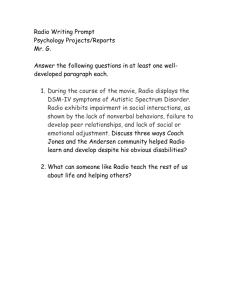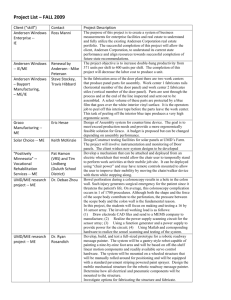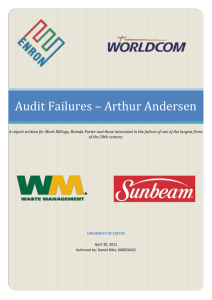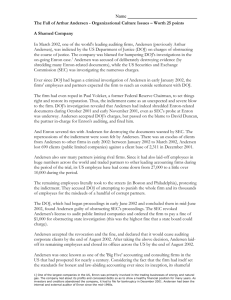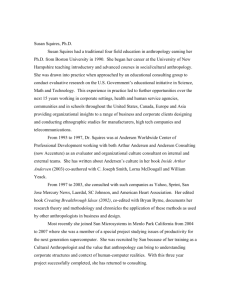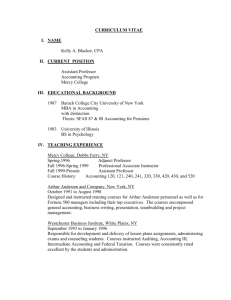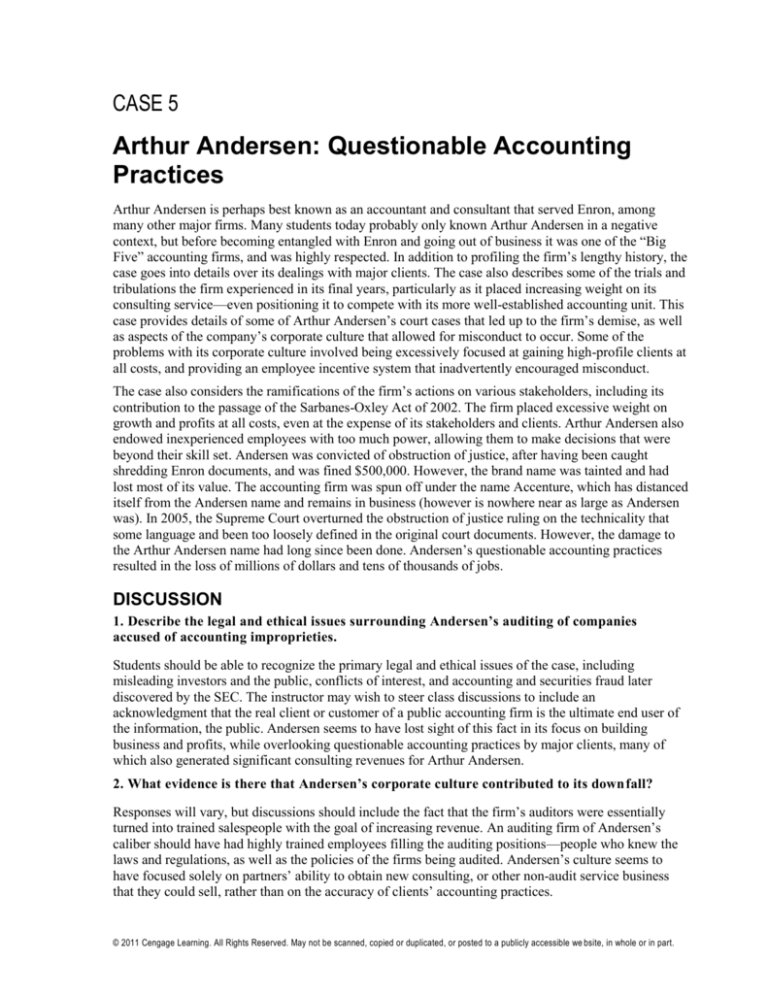
CASE 5
Arthur Andersen: Questionable Accounting
Practices
Arthur Andersen is perhaps best known as an accountant and consultant that served Enron, among
many other major firms. Many students today probably only known Arthur Andersen in a negative
context, but before becoming entangled with Enron and going out of business it was one of the “Big
Five” accounting firms, and was highly respected. In addition to profiling the firm’s lengthy history, the
case goes into details over its dealings with major clients. The case also describes some of the trials and
tribulations the firm experienced in its final years, particularly as it placed increasing weight on its
consulting service—even positioning it to compete with its more well-established accounting unit. This
case provides details of some of Arthur Andersen’s court cases that led up to the firm’s demise, as well
as aspects of the company’s corporate culture that allowed for misconduct to occur. Some of the
problems with its corporate culture involved being excessively focused at gaining high-profile clients at
all costs, and providing an employee incentive system that inadvertently encouraged misconduct.
The case also considers the ramifications of the firm’s actions on various stakeholders, including its
contribution to the passage of the Sarbanes-Oxley Act of 2002. The firm placed excessive weight on
growth and profits at all costs, even at the expense of its stakeholders and clients. Arthur Andersen also
endowed inexperienced employees with too much power, allowing them to make decisions that were
beyond their skill set. Andersen was convicted of obstruction of justice, after having been caught
shredding Enron documents, and was fined $500,000. However, the brand name was tainted and had
lost most of its value. The accounting firm was spun off under the name Accenture, which has distanced
itself from the Andersen name and remains in business (however is nowhere near as large as Andersen
was). In 2005, the Supreme Court overturned the obstruction of justice ruling on the technicality that
some language and been too loosely defined in the original court documents. However, the damage to
the Arthur Andersen name had long since been done. Andersen’s questionable accounting practices
resulted in the loss of millions of dollars and tens of thousands of jobs.
DISCUSSION
1. Describe the legal and ethical issues surrounding Andersen’s auditing of companies
accused of accounting improprieties.
Students should be able to recognize the primary legal and ethical issues of the case, including
misleading investors and the public, conflicts of interest, and accounting and securities fraud later
discovered by the SEC. The instructor may wish to steer class discussions to include an
acknowledgment that the real client or customer of a public accounting firm is the ultimate end user of
the information, the public. Andersen seems to have lost sight of this fact in its focus on building
business and profits, while overlooking questionable accounting practices by major clients, many of
which also generated significant consulting revenues for Arthur Andersen.
2. What evidence is there that Andersen’s corporate culture contributed to its downfall?
Responses will vary, but discussions should include the fact that the firm’s auditors were essentially
turned into trained salespeople with the goal of increasing revenue. An auditing firm of Andersen’s
caliber should have had highly trained employees filling the auditing positions—people who knew the
laws and regulations, as well as the policies of the firms being audited. Andersen’s culture seems to
have focused solely on partners’ ability to obtain new consulting, or other non-audit service business
that they could sell, rather than on the accuracy of clients’ accounting practices.
© 2011 Cengage Learning. All Rights Reserved. May not be scanned, copied or duplicated, or posted to a publicly accessible we bsite, in whole or in part.
66
Case 5: Arthur Andersen: Questionable Accounting Practices
Moreover, the company had few checks and balances in place, meaning that each business unit
throughout the world had the authority to approve the services they provided. In many cases, different
units were unaware of what other units were doing. Students may notice parallels to the AIG or
Countrywide cases in this book, where rogue departments made risky decisions without communicating
their actions to top management or to other departments.
3. How can the provisions of the Sarbanes–Oxley Act help minimize the likelihood of auditors
failing to identify accounting irregularities?
Answers will vary, but students should mention the Public Company Accounting Oversight Board,
which is responsible for the review and inspection of accounting firms, as well as the provision to
require a financial expert on the corporate audit committees, which now must comprise independent
members with no association with management. Another important element of the act is Section 404,
which requires executives to assess their firms’ internal controls, address risks, and sign-off on all
financial statements. The act also holds independent auditors responsible for issuing an opinion on the
internal control structure of the company being audited. Section 406 requires the CEO and the CFO to
sign off on their own personal code of ethics pertaining to the issuance of the financial statements.
© 2011 Cengage Learning. All Rights Reserved. May not be scanned, copied or duplicated, or posted to a publicly accessible we bsite, in whole or in part.

